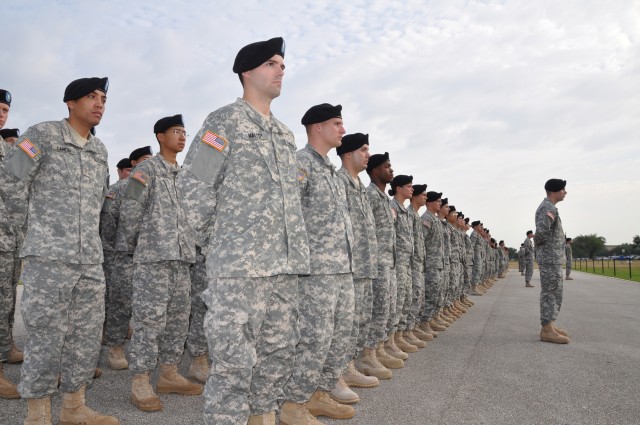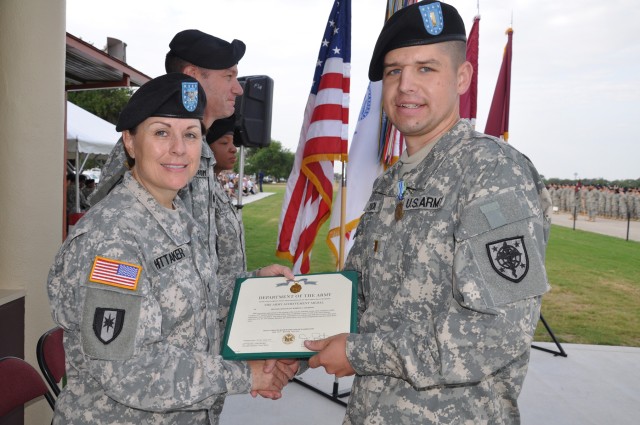FORT SAM HOUSTON, Texas -- The Academy of Health Sciences, under the Army Medical Department Center & School, is a complex institution with the mission to develop, train and educate military medical personnel.
As the dean of the AHS, Col. Donna Whittaker manages 14 teaching departments providing 315 programs of instruction to officers, enlisted and foreign students with a total staff and faculty of 1,860, and an average daily student load of 4,900.
The academic departments within the Academy of Health Sciences are: Center for Pre-Deployment Medicine; Leader Training Center; Nursing Science; Medical Science; Preventive Health; Veterinary Science; Pastoral Ministry Training; Behavioral Health Science; U.S. Army School of Aviation Medicine; Combat Medic; Clinical Support; Dental Science; Health Services Administration; Health Education and Training; and the Graduate School. Of the 315 programs, 41 will move to the Medical Education and Training Campus, all others will remain at AHS.
"Our job is to educate and train medically-focused Soldiers in leadership and medical skills," said Whittaker.
"Training the officer and the enlisted medical force in those tasks and skills that are required to support the ground Soldiers is the bottom line; we are here to medically support the Soldier in the field," said Emil Meis, deputy for the Leader Training Center, one of the 14 teaching departments under the AHS.
"The 315 different programs range from a one-week course to doctoral studies," said Whittaker. All courses are reviewed by the American Council on Education. Students attending courses can get undergraduate and graduate college credits.
She noted the AHS does not confer any degrees, so it partners with universities to support six master degree and five doctoral programs. These affiliations include Baylor University, University of Nebraska Medical Center, Northeastern University, Fayetteville State University and Erskine Theological Seminary. Students can earn master's degrees in health and business administration, nutrition, anesthesia nursing, physician assistant studies, and social work; and doctoral degrees in physical therapy, occupational therapy, pastoral care, physician assistant in emergency medicine or clinical orthopedics, sports medicine-physical therapy, and orthopedic and manual physical therapy.
The AMEDDC&S is accredited by the Council on Occupational Education and by the U.S. Army Training and Doctrine Command. Students attending courses range from students who have completed basic combat training and do not have Army skills, to brand new officers right out of college.
"And we get all the way up to some senior leaders who attend the strategic leadership course. So we have the full spectrum. Throughout the Army medical person's career they can come back to Fort Sam Houston for all their education and training needs." Whittaker said.
"For leadership development, I like to call it "from cradle to grave leadership", said Meis. "We take a brand new officer in the Leader Training Center, right out of college or medical school, and sometimes those who are still in medical school, based on whether the Army is funding that medical school attendance, all the way through the very senior level officer leadership courses at the lieutenant colonel and colonel level.
We teach courses to refine the leadership skills of officers below the rank of general at the more senior level to help develop a more strategic perspective on the military medical community worldwide.
Whittaker said the medical enlisted force attends the advanced leader course and the senior leader course hosted by the Army Medical Department NCO Academy.
"It is not completely cradle to grave educational and professional development training for medical personnel because units have training requirements and responsibilities for Soldiers assigned to them," said Whittaker. The AHS offers a variety of professional development and distributed learning courses which officers and enlisted personnel take to prepare them for assignments such as pest management or behavioral health.
The Leader Training Center with a staff and faculty of 100 conducts 14 different leadership courses, with an output of 4,500 officers a year. Col. Jeffrey Haun is the chief of the center.
Every Army officer regardless of branch of service whether they are an infantryman, artilleryman or a finance officer entering the Army is required to go to a basic course of instruction. For example, on July 26, 482 students graduated from the Basic Officers Leaders Course held once a year for health professional scholarship students and Uniformed University of the Health Services and students beginning medical school.
"This is the first step in what we call the PME, or professional military education," said Meis. The Leader Training Center is responsible for two steps of PME, the BOLC and then the Captains Career Course. An officer between their fourth and seventh year of service comes here for the Captains Career Course which basically teaches them how to lead and operate in company size unit and work on staffs, said Meis.
However, in the Army medical department officers by their fourth and seventh year may be Majors or Lieutenant Colonels because of their level of medical specialty that they had when they came into the Army.
"All doctors when they come into the Army are Captains when they graduate from medical school, so by their fourth and seventh year they may be a Major," said Meis. Meis said they have had a few Lieutenant Colonels who are brand new to the Army and don't know anything about the Army, so this is their basic level of training.
The Medical Strategic Leadership course is offered three times a year for senior officers usually at the Colonel level or senior Lieutenant Colonel level. The course is comprised of 10 US officers and 10 international officers. The 10 U.S. officers normally include a Navy officer and an Air Force officer from their medical service. The 10 international officers are from partner nations around the world.
"Right now we have a course in session that is in Washington D.C. and frequently we get general officers from other countries. We have a brigadier general officer equivalent from Nepal in the current course," said Meis. Foreign officers spend two weeks at Fort Sam Houston becoming familiar with the Army Medical Department military strategic perspective, and then go to Washington D.C. to visit the Pentagon, the office of the Army Surgeon General, and the United Nations in New York City to help develop a more strategic perspective on our military.
International students are assigned to the AHS International Military Student Office.
The AMEDD Pre-Command Course is a seven-day course for officers who are board selected for lieutenant colonel or colonel level medical command, such as a tactical medical unit or a hospital. Whether they are dentists, nurses, doctors, medical service corps, or veterinarians, they are required to attend a pre-command course of their service and an Army pre-command course at Fort Leavenworth. The course prepares the officer for the command responsibility.
The Executive Skills Course convenes once a year and is conducted for senior AMEDD officers who are going into positions as deputy commanders for administration, or DCA, or deputy commander for clinical services or DCCS or deputy commander for nursing at a medical center.
The Division Surgeons and Brigade Surgeons Courses are two week-long courses for physicians who are selected for assignments as a division surgeon or brigade surgeon. The courses offer an opportunity to learn how the organizations function so they can assume the role as a staff advisor to a commander in those units.
The Forward Surgical Team Commander Course provides the student the opportunity to learn about the Forward Surgical Team organization and how as doctors are employed so they understand the mission of the FST before they take command.
The Health Services Plans, Operations, Intelligence, Security & Training Course, is a course offered to officers who are currently assigned or preparing for a position that calls for a 70 hotel AOC officer and have never been in those positions. Whether the officer is reserve or active duty, the course gives instruction on medical doctrine, and those specific areas that help make them successful as staff officers in tactical units or major commands.
Whittaker summed up how AHS fits in with AMEDDC&S. "The AMEDDC&S has a center portion and a school portion, and the AHS and the NCO Academy are the school portion of the center and school."
This article is part one of four, a series of articles about the courses offered through AHS.
(Col. Donna Whittaker and Emil Meiss contributed to this article)




Social Sharing